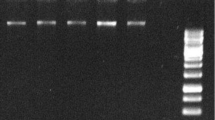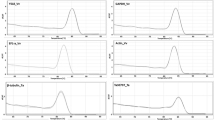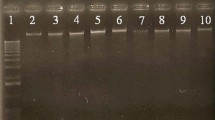Abstract
Isolation of high quality nucleic acids from plant tissues rich in polysaccharides and polyphenols is often difficult. The presence of these substances can affect the quality and/or quantity of the nucleic acids isolated. Here, we describe a rapid and efficient nucleic acids extraction protocol that in contrast to other methods tested, effectively purify high quality nucleic acids from plant tissues rich in polysaccharides and polyphenolic compounds such as different grape tissues and fruit tissue of fruit trees. The nucleic acids isolated with this protocol were successfully used for many functional genomic based experiments including polymerase chain reaction, reverse transcription polymerase chain reaction (RT-PCR), cloning, and semiquantitative RT-PCR.




Similar content being viewed by others
Explore related subjects
Discover the latest articles and news from researchers in related subjects, suggested using machine learning.Notes
Pestles, mortars and all glassware used in the isolation of total RNA from plant material are baked for 2 h at 180ºC. Also, 2 ml Eppendorf tubes and tips are immersed overnight in 0.1% DEPC treated water and then autoclaved for 30 min.
For isolation of total RNA, EDTA, NaCl, NaOAc, and LiCl are treated with 0.1% DEPC solution and stored overnight, then are autoclaved for 30 min. Tris–HCl and 70% EtOH are prepared with 0.1% DEPC-treated, autoclaved distilled water.
Isolation of total RNA should carry out at 4°C, whereas genomic DNA extraction is performed at room temperature.
The extraction procedure can be scaled up or down depending on the amount of initial plant tissue available and the quantity of nucleic acid required.
In the isolation of total RNA, tissues should grind to a fine powder, but for genomic DNA extraction, it is not necessary that tissues grind completely.
At this point, the pellet is white and clear. Do not let the pellet dry completely. Immediately resuspend the pellet in an adequate volume of TE buffer or DEPC-treated water.
If the pellet is unclear, centrifuge at 14000 rpm for 1 min to remove any trace of plant material in nucleic acid solution.
At this point, it is important to remove all supernatant to prevent carryover of contaminating substances.
Abbreviations
- Chl:Iaa:
-
Chloroform-isoamylalcohol
- CTAB:
-
Cetyltrimethylammonium bromide
- DEPC:
-
Diethyl pyrocarbonate
- EDTA:
-
Ethylenediaminetetra acetic acid
- EtBr:
-
Ethidium bromide
- EtOH:
-
Ethanol
- FW:
-
Fresh weight
- PVPP:
-
Polyvinylpolypyrrolidone
- PVP:
-
Polyvinylpyrrolidone
- NaOAc:
-
Sodium acetate
- RT-PCR:
-
Reverse transcription polymerase chain reaction
References
Asif, M. H., Dhawan, P., & Nath, P. (2000). A simple procedure for the isolation of high quality RNA from ripening banana fruit. Plant Molecular Biology Reporter, 18, 109–115.
Salzman, R. A., Fujita, T., Zhu-Salzman, K., Hasegawa, P. M., & Bressan, R. A. (1999). An improved RNA isolation method for plant tissues containing high levels of phenolic compounds or carbohydrates. Plant Molecular Biology Reporter, 17, 11–17.
Iandolino, A. B., Goes Da Silva, F., Lim, H., Choi, H., Williams, L. E., & Cook, D. R. (2004). High-quality RNA, cDNA and derived EST libraries from grapevine (Vitis vinifera L.). Plant Molecular Biology Reporter, 22, 269–278.
Gehrig, H. H., Winter, K., Cushman, J., Borland, A., & Taybi, T. (2000). An improved RNA isolation method for succulent plant species rich in polyphenols and polysaccharides. Plant Molecular Biology Reporter, 18, 369–376.
Carra, A., Gambino, G., & Schubert, A. (2007). A cetyltrimethylammonium bromide based method to extract low-molecular-weight RNA from polysaccharide-rich plant tissues. Analytical Biochemistry, 360, 318–320.
Moser, C., Gatto, P., Moser, M., Pindo, M., & Velasco, R. (2004). Isolation of functional RNA from small amounts of different grape and apple tissues. Molecular Biotechnology, 26, 95–99.
Cheng, Y. J., Guo, W. W., Yi, H. L., Pang, X. M., & Deng, X. (2003). An efficient protocol for genomic DNA extraction from Citrus species. Plant Molecular Biology Reporter, 21, 177a–177g.
Hanania, U., Velcheva, M., Sahar, N., & Perl, A. (2004). An improved method for isolating high-quality DNA from Vitis vinifera nuclei. Plant Molecular Biology Reporter, 22, 173–177.
Gasic, K., Hernandez, A., & Korban, S. S. (2004). RNA extraction from different apple tissues rich in polyphenols and polysaccharides for cDNA library construction. Plant Molecular Biology Reporter, 22, 437a–437g.
Meisel, L., Fonseca, B., Gonzalez, S., Yates, R. B., Cambiazo, V., Campos, R., et al. (2005). A rapid and efficient method for purifying high quality total RNA from peaches (Prunus persica) for functional genomic analyses. Biology Research, 38, 83–88.
Zeng, Y., & Yang, T. (2002). RNA isolation from highly viscous samples rich in polyphenols and polysaccharides. Plant Molecular Biology Reporter, 20, 417a–417e.
Reid, K. E., Olsson, N., Schlosser, J., Peng, F., & Lund, S. T. (2006). An optimized grapevine RNA isolation procedure and statistical determination of reference genes for real-time RT-PCR during berry development. BMC Plant Biology, 6, 27–37.
Dal Cin, V., Danesin, M., Rizzini, F. M., & Ramina, A. (2005). RNA extraction from plant tissues. Molecular Biotechnology, 31, 113–119.
Sambrook, J., & Russell, D. W. (2001). Molecular cloning: A laboratory manual. Cold Spring Harbour, New York: Cold Spring Harbour Laboratory Press.
Abbasi Kejani, A., Hosseini Tafreshi, S. A., Khayyam Nekouei, S. M., & Mofid, M. R. (2010). Efficient isolation of high quality nucleic acids from different tissues of Taxus baccata L. Molecular Biology Reporter, 37, 797–800.
Ainsworth, C. (1994). Isolation of RNA from floral tissue of Rumex acetosa (Sorrel). Plant Molecular Biology Reporter, 12, 98–203.
Fillion, L., Ageorges, A., Picaud, S., Coutos-Thevenot, P., Lemoine, R., Romieu, C., et al. (1999). Cloning and expression of a hexose transporter gene expressed during the ripening of grape berry. Plant Physiology, 120, 1083–1093.
Malnoy, M., Reynoird, J. P., Mourgues, F., Chevreau, E., & Simoneau, P. (2001). A method for isolating total RNA from pear leaves. Plant Molecular Biology Reporter, 19, 69a–69f.
Hu, C. G., Honda, C., Kita, M., Zhang, Z., Tsuda, T., & Moriguchi, T. (2002). A simple protocol for RNA isolation from fruit trees containing high levels of polysaccharides and polyphenol compounds. Plant Molecular Biology Reporter, 20, 69a–69g.
Xu, Q., Wen, X., & Deng, X. (2004). A simple protocol for isolating genomic DNA from chestnut rose (Rosa roxburghii Tratt) for RFLP and PCR analyses. Plant Molecular Biology Reporter, 22, 301a–301g.
Hameed, A., Malik, S. A., Iqbal, N., Arshad, R., & Farooq, S. (2004). A rapid (100 min) method for isolating high yield and quality DNA from leaves, roots and coleoptile of wheat (Triticum aestivum L.) suitable for apoptotic and other molecular studies. International Journal of Agricultural and Biology, 6, 383–387.
Kang, T. J., & Yang, M. S. (2004). Rapid and reliable extraction of genomic DNA from various wild-type and transgenic plants. BMC Biotechnology, 4(20), 1–12.
Sharma, A. D., Gill, P. K., & Singh, P. (2002). DNA isolation from dry and fresh samples of polysaccharide-rich plants. Plant Molecular Biology Reporter, 20, 415a–415f.
Sharma, R., Mahla, H. R., Mohapatra, T., Bhargava, S. C., & Sharma, M. M. (2003). Isolating plant genomic DNA without liquid nitrogen. Plant Molecular Biology Reporter, 21, 43–50.
Author information
Authors and Affiliations
Corresponding author
Rights and permissions
About this article
Cite this article
Japelaghi, R.H., Haddad, R. & Garoosi, GA. Rapid and Efficient Isolation of High Quality Nucleic Acids from Plant Tissues Rich in Polyphenols and Polysaccharides. Mol Biotechnol 49, 129–137 (2011). https://doi.org/10.1007/s12033-011-9384-8
Published:
Issue Date:
DOI: https://doi.org/10.1007/s12033-011-9384-8




